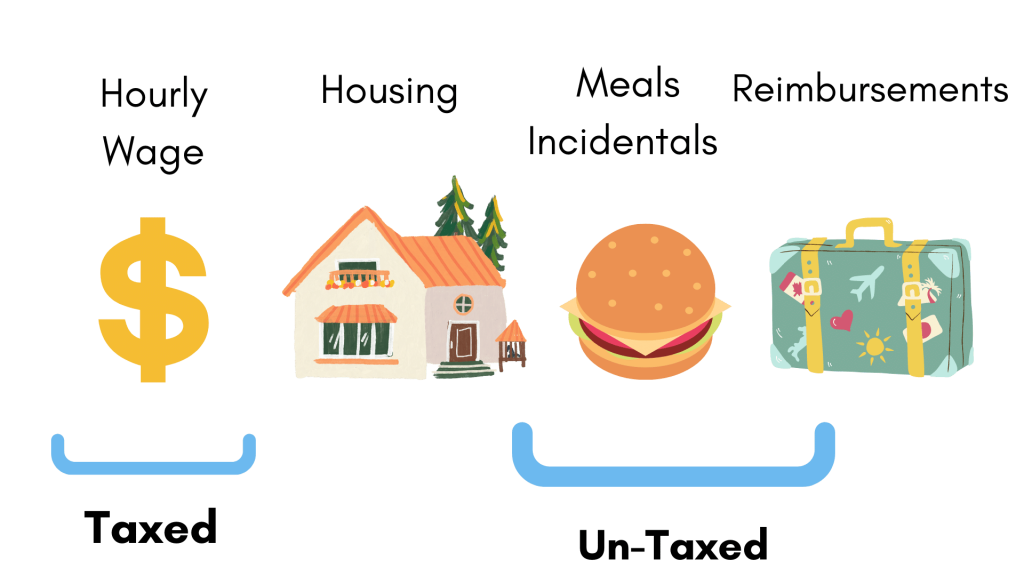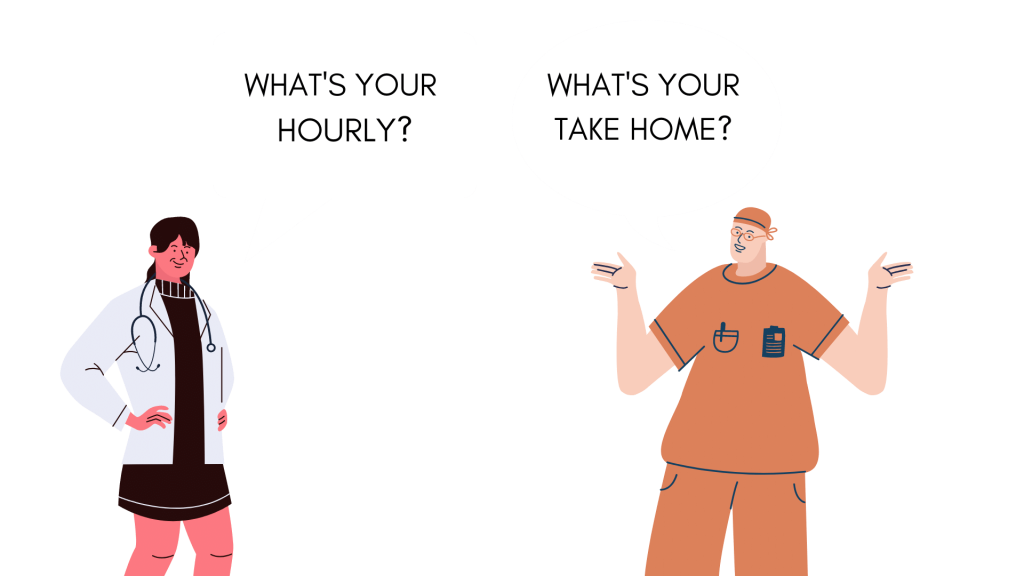Let’s break down those travel therapy pay rates. In other words, how much money can you make as a traveling therapist? Where does that money come from? And how does the pay work? If seeing travel therapy pay rates has left you confused in the past, I’m here to help make it clear.
Travel Therapy Pay: How Does It Work?
As traveling therapists, we get paid differently than we would on a normal salary or hourly rate – such as at a permanent, full-time job.
But why is that? For one, we don’t work annually. Instead, we’re working on a week-to-week basis (for our 13-week contract), so we don’t discuss pay in terms of an annual salary. We also don’t discuss pay in terms of a strict ‘hourly’ rate, because we often receive tax-free stipends as part of our weekly pay.
So as a traveling therapist, you’re going to be paid a taxed hourly rate. Plus you receive a stipend for housing, meals, and incidents (which is usually untaxed, as long as you meet the requirements of a proper tax home).
If you maintain a “Tax Home” at your permanent residence and travel to an assignment away from your home for work, you can get a tax break on the stipend part of your pay for housing. At the end of the day, since you don’t have to pay taxes on that part of your pay, you often end up making more money after taxes than at a regular job, where all of your pay is taxed.
The thing to understand here is that you’re not just getting paid for the hourly work that you do. You’re also receiving reimbursement for the expenses that come with being a traveler and not living in a place full-time.
And some travel therapists can receive additional reimbursements for things like their state license, scrubs, and mileage/travel to get to the assignment.
Your pay is going to be broken into segments that make up your “Pay Package“: Hourly Rate + Stipends/Per Diems + Reimbursements.

Who pays you as a travel therapist? & What is a Bill Rate?
Now we’re going to talk about who is actually paying you – in other words, who you work for! This will help you understand what a bill rate is and what factors are determining your take-home pay.
It’s important to note that you’re an employee of your recruiting company, not the contract facility where you’re working. The recruiting company is the one paying your salary and providing you with benefits. Your travel therapy pay will come from the recruitment office, and you’ll be negotiating your pay package as a traveler with your recruiter.
The money that the recruiting company receives from the facility (hospital, home health agency, SNF, etc) is called the ‘Bill Rate’.
To keep things simple, the bill rate is the hourly rate that the facility is paying for travelers. It’s the money that you and the recruiting company share for the work done. Yup, it’s the money that pays you, but it’s also the money that the recruiting company uses to pay their recruiters, pay for insurance costs, and the coffee brewed in the break room.
A lot of times, the recruiting company might not tell travelers exactly what the bill rate is. Here’s a great article that Blue Pipes shared about why that is.
When you’re talking to your recruiter about a potential job they’re going to talk to you about your “Weekly Take-Home”. The weekly take-home is the money that you’re going to make every week (between your stipends and hourly rate).

Who determines the travel therapy bill rate?
Because we get paid by our staffing agencies, it is a common misconception that the staffing agencies set the travel therapy bill rate. This is false.
The travel therapy bill rate is actually determined by the facility that is employing you. So the hospital, school, home health agency, clinic, etc are the ones who determine the rate. They then submit that rate to the staffing agency and the agency uses that rate to determine your pay package.
How do you calculate a “Weekly Take Home” number?
You take the hourly rate and multiply it by the hours you worked. For example, $20/hr x 40hrs = $800
Then, you subtract out the taxes you have to pay on that amount, which depends on your state and your tax filing status (for example single/married and if you claim dependents).
So let’s say you owed 30% taxes, it would be $800 x 70%= $560 after taxes
Then, you’ll add in your weekly stipends, for example, $1000/wk total for meals/housing/incidentals.
So if your pay was $20/hr + $1000/wk stipends, your “weekly take home” amount would be: $560 (after taxes) + $1000 (untaxed) = $1560/wk after taxes!
Is there money outside of the Bill Rate?
Nope, not at all. The bill rate pays for everything when it comes to working as a traveling therapist. It pays your bills, your housing, the bills of your recruiter, and keeps the recruiting office running.
The goal of the whole traveling healthcare industry is to get qualified skilled travel therapists (you!) to a place that needs us to fill a gap in their patient care. So the facility that needs the assistance is going to determine the hourly rate they can afford to pay, to have us come.
Our recruitment agencies do a ton of work for both the travelers and the facilities. They also take away some of the liability. Most of them carry extensive medical malpractice policies to cover their therapists if they get sued (which happens).
Remember, we work for the agency, not the facility, so everything from medical malpractice to short or long-term disability is paid for by them. These things can be crazy expensive, and they only get that money from the bill rate.
It’s important to note that the bill rate is not “our” money as travelers. Only part of it is (the pay rate). The bill rate was designed to be shared between us and every person who helped get us to that job.

How much say do you have in what you get paid?
Once the money gets to the travel company, they’ll decide how to divide it up for the traveler (you!). And this is where you’ll have some input into your weekly take-home. The money can be allocated in different ways to maximize the tax benefits for you and the agency. As long as they’re following the IRS guidelines for per diems, they can put more money towards your housing/food stipend. This money goes untaxed (usually) and less money towards your hourly pay (which is taxed).
The really important thing here is that none of this is ‘free’ money. There isn’t any free money lying around. You can think of this as a pie. You and the recruiting company are sharing the pie, and you can cut the pie in various ways to make the deal sweeter for both parties. No matter how you cut it though, it’s always the same pie.
Some recruiting companies use gimmicks to make it seem like you’re getting more out of the deal. They’ll say things like, “You’ll get a tuition stipend!” or “We offer bonuses for this or that!” but as a savvy traveler, you’ll know that the money has to come from somewhere.
Either, that money comes directly out of the bill rate for that specific contract, or, the travel company might allocate a particular budget to a department to give out money for things like licensure costs or bonuses. At the end of the day, don’t get dragged into the ‘extras’ because it’s always going to affect your weekly take-home pay.
How much money do travel therapists normally make?
Your pay as a travel therapist is still going to vary greatly. (I know by this point you just wanted me to tell you how much money you’ll make!) Your travel therapy pay will be determined by the facility, the location, season of the year (e.g. flu season tends to have higher contract rates), and your recruitment company. This is all very important to keep in mind if you’re trying to compare your weekly take-home pay between two agencies or two potential contracts.
What’s a typical range?
At the time of writing this article, a typical range for a traveling therapist’s pay is going to be around $1500-1800/wk after taxes (for Speech Language Pathologist!). That’s the typical range for physical and occupational therapists as well. If you’re a PTA/COTA, you could see pay typically between $1000-1300/wk.
Home health is typically the highest paying traveler job, while an SNF Is typically going to be the lowest. Outpatients, schools, and hospitals tend to fall somewhere in the middle. Higher paying areas are typically on the west coast – particularly in California. And of course, your travel company makes a difference too! That will be determined by how much they keep for their own overhead.
What percentage of the bill rate do travel therapy agencies keep?
According to SIA (Staffing Industry Analysts) data, staffing agencies on average keep 23% of the bill rate for their gross margin and approximately another 5% of the bill rate to pay your benefits. If the staffing agency has to pay a vendor for access to a job (this is very common), another 3-9% of the bill rate might go towards paying the vendor.
The means that you might receive anywhere from 25-35% on average of the bill rate in your pay. These numbers can definitely vary.
Breakdown of a typical travel therapy pay package
- 51% package goes to travelers hourly rate
- 21% to tax free housing, meals, and incidental expenses
- 5% to travelers benefits such as workers compensation, malpractice insurance, health insurance, and other benefits
- 23% to the travel therapy staffing agency gross margins which goes to pay all of their business expenses (payroll, staff, offices, office supplies, desks, marketing, consultants, lawyers, etc.)
Here is a visual to help you understand:
Nothing is Free
The biggest take away that I hope you learn from this article is that nothing in a travel therapy pay package is free. Everything you get in reimbursement from your pay package all comes from one bill rate. Don’t be fooled with tactics like “free housing”, “free bonus”, or “free CEU or scrub reimbursement”. They are all a distribution of your money.
The Bottom Line
So as you can see, one of the biggest benefits of working in traveling healthcare is the ability to make more money. Your travel therapy pay will be higher than you would at a typical full-time job where you live. But there are so many factors that go into your travel therapy pay. And understanding bill rates and take-home pay can be confusing. Here’s my biggest advice that I hope you take away from this article.
- Don’t focus so much on bill rates. Instead, learn to read your pay packages and how to get high offers.
- NOTHING IS FREE! Everything comes out of your bill rate and if you increase one thing (such as a reimbursement), you will be lowering something else over the course of your contract.
- Always keep in mind the benefits that you need, as they can impact your take-home pay a lot.
- Look out for overtime and extra shift bonuses
- Try and work with 3 honest recruiters and compare offers between each assignment you are setting yourself up for fair pay every time!
- Use the fair pay calculator from Nomidcare – this is the tool that will help you negotiate!
Learning and understanding how pay works before you dive in and get started as a traveler is so important! To learn more, check out this Comprehensive Course for Travel Therapists. I have an entire lesson on understanding and maximizing your pay!
Please contact me if you have questions about getting started with your travel therapy journey and get recommendations for great recruiters.
Free E-Book & Newsletter
Subscribe to get our latest content and stay up to date by email

Great Information 👍. I have more questions.